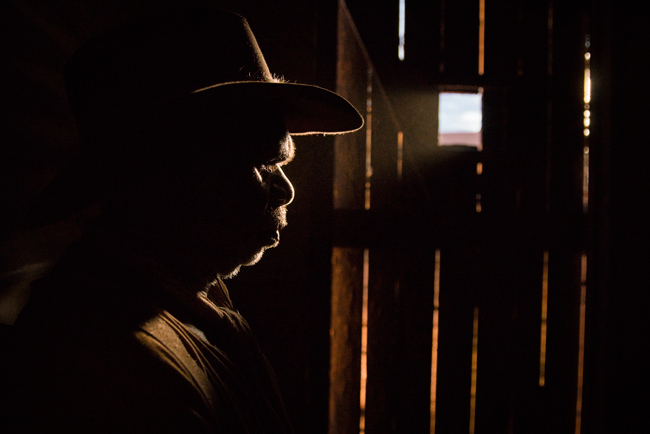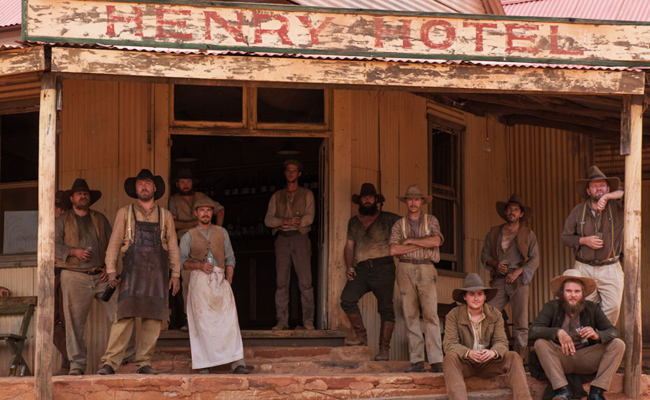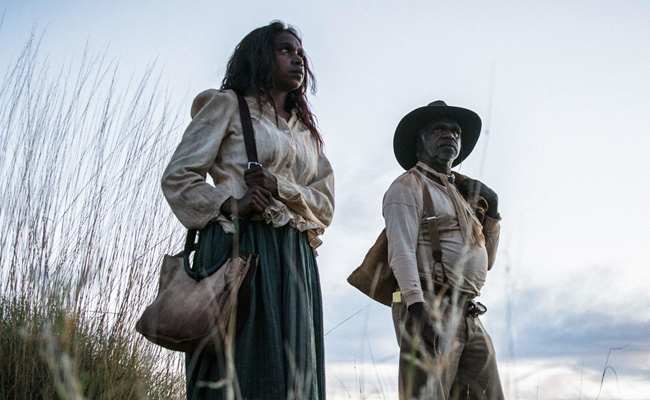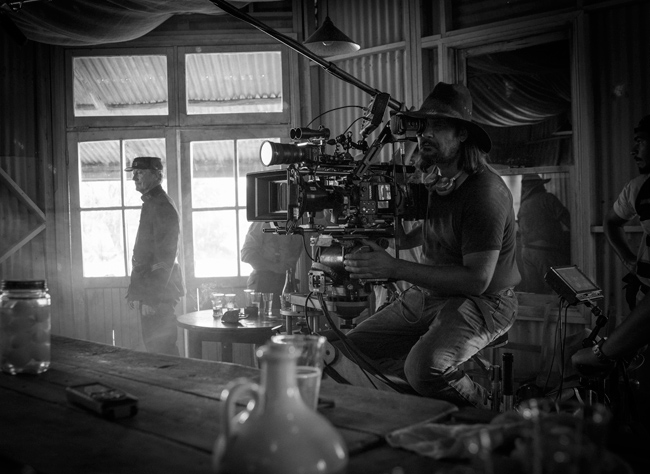
The cinematic Western started in large part as a justification of manifestation destiny, glorifying the rugged, upright white settler in his struggle against the savage native. On a longer timeline, filmmakers continue to reinvent the genre, and one of its strengths has proven to be its adaptability. The Lone Ranger-ish white hats of the 1950s gave way to the anti-heroes of the 1970s, and these days, the Western is becoming useful as a familiar framework for stories with more exotic settings, and interestingly, as a way to tell the stories of those same colonized people.
Late last year we wrote about a pair of white South African filmmakers telling the story of a rail town on the eastern cape, shot entirely in Sesotho language, in Five Fingers For Marseilles. This year’s Sundance Film Festival brings us Sweet Country, an Australian Western set in the central desert post WWI, telling the story of an Aboriginal cowboy (Hamilton Morris) on the run from a local constable (Bryan Brown), with the cowboy’s wife (Anni Finsterer), a white missionary (Sam Neill), and a local boy (twins Tremayne and Trevor Doolan) all getting caught up in the mix.
If there was a Mount Rushmore of Australian cinema, Bryan Brown and Sam Neill would probably be on it (I realize Neill is technically a Kiwi, I still think he’s been in enough Aussie films to warrant the honor). But unlike in the case of Marseilles, Sweet Country‘s director, Warwick Thornton, actually comes from the community he depicts. It not only rings with authenticity, it’s visually beautiful in a way that only a cinematographer shooting the town he grew up in can be.
And it’s a good thing it’s so pretty, because Thornton doesn’t spare the brutality of Australia’s genocidal colonial period. I won’t sugar coat it, Sweet Country is a tough watch. For Thornton, this isn’t just an artistic choice but a duty, to tell the truth that all those white hat westerns tried to obscure. Or as he puts it, as only an Australian could: “for the last 200 years, indigenous people have had to drink a lot of concrete and harden the f*ck up. So, it’s about the time that the rest of Australia drink some concrete and harden the f*ck up with us.”
How can you not like a guy who talks like that? Thornton draws a connection between his work and indigenous people’s oral history, that kept their stories and culture alive in times of crisis. Sweet Country, in fact, came from a sound recorder Thornton had worked with and knew from childhood — it was the story of the sound designer’s own grandfather. So in a way, Thornton’s job as director is just the modern evolution of that same oral history — utilizing the post-Captain Cook Australians’ medium (film), form (the western), and favorite actors (Brown and Neill) to preserve pre-Captain Cook Australians’ stories and identity.
I sat down with Thornton this week at Sundance.

—
Can you tell me a little bit about your upbringing, and how you came to directing?
I was born in central Australia, in a town called Alice Springs, in the 70s. Kind of a frontier town, full of angels and demons. Where I come from, the only way out of the town is if you can play sports, be drafted in some kind of national league. I was terrible at kicking a football or throwing anything. And I actually started off as a DJ, a radio DJ at the age of 16. Didn’t really go to school, didn’t give a shit about school. Education, for me, I didn’t find very important until I got older. And then I wanted to write for movies and I couldn’t spell. Like, “See, you should have went to school, you idiot.”
It didn’t stop Tarantino…
…Yeah. But, cinema in a strange way was escapism for me. But not going to the cinema. It was like joining the circus and running away. I started off as a camera assistant carrying boxes, and then went to focus pulling, and then to camera operating, and then I started to travel which was fantastic. And that’s how I got out of the town I lived in. Ironically, this film, that’s where I sort of went back to Alice Springs, to make this western.
What was that like?
Good, good. It was fun, because after reading the script and agreeing to do it, I kind of knew exactly where every shot, every scene was going to be set. Because Alice Springs is incredibly beautiful, and has valleys and mountain ranges, and everything you kind of need to make a Western in a 50 square kilometer area. So, it was kind of exciting, and you know, every director wants to make a western. It was nice to go home.
Can you expand on angels and demons a little bit?
Oh, it’s like everywhere, you know? The irony of a classic western is that the good guy wears a white hat, and a bad guy wears a black hat, and never shall their morals meet in the middle of the street, you know what I mean? Maybe their bullets will. See, I grew up in a frontier town full of racists and full of incredibly beautiful people, and everyone had to kind of get on in a way. So, it was full of angels, and it was full of demons. Full of the most racist people you’ll ever meet in your entire life, and full of the most incredibly beautiful human beings that would give you their last dollar.
What does racism look like there? Is it straightforward, is it subtle?
Up until the 80s, it was straightforward. You’d be called whatever name anybody wanted to call you, as an indigenous person. And then obviously that became not cool. They’re still there, you know what I mean? There’s still just as many racists in the town that I live in, except they use the internet now rather than they use their mouths.
Were there any real events that inspired this movie?
Yeah, it’s based on a true on a story. It’s based on the sound recorder’s grandfather. I knew the sound recorder, we grew up on the same street in the same town, in Alice Springs. And we met when we were six, and for some strange weird fate life thing, he became a sound recorder and I became a sound recorder, then a director of photography. So, he pitched the story to me a couple years ago and I told him to go away and write it, expecting him not to. And then he did write it, and he came back a year or two later, and said, “Here’s the script.”
And it wasn’t very well written, but at least he got off his ass and wrote it, you know? And was empowered by the story, and I felt like that was the more important thing, the bigger picture.
Sure.
And then we just got another writer to help him fix the problems with it, and then it was beautiful.
Tell me about finding the line between appropriately bleak, and too bleak, and appropriately brutal, and too much?
When you’re indigenous, and you have access to cinema, to that screen, it’s not a right, it’s not a given. You actually have to be very careful what you do with it, because the films that I’m trying to make, and a lot of indigenous filmmakers around the world are trying to just catch up with the pieces of their history that actually have been erased by colonizers, who actually just don’t wanna talk about the past because it’s all a bit too hard.
Even here, it’s sort of… in the last 10, 20 years, there’s been a recognition of the people who were here before. But it hasn’t progressed to the next step, “Why aren’t they here anymore?” You know what I mean?
Right.
“Oh no, let’s not talk about that.” Let’s not talk about smallpox in blankets and let’s not talk about guns and massacres, and let’s not talk about poison and stealing children of mixed race and then sort of trying to get them educated and then pawn them off as slave workers. Let’s not talk about any of that. So, we’re just still in these transitions, but we as indigenous people wanna talk about those bits.
So, there is a balance, but I always say, look, indigenous people around the world for the last … well, in Australia, for the last 200 years, have had to drink a lot of concrete and harden the f*ck up. So, it’s about the time that the rest of Australia drink some concrete and harden the f*ck up with us, you know what I mean?
That’s a great quote.
Because it’s kind of like, why did momma need to talk about the past? Because we haven’t. And we need to. The country needs to know its past before it can make better decisions about its bloody future, you know? But we’ll talk about World Wars, and we’ll talk about everything, and we have the ANZACs, who are amazing people. And naturally, aboriginal people were ANZACs. We were allowed to go to war and die but we weren’t allowed to come back and be citizens, you know what I mean? But Australia loves to talk about the ANZACs, but why talk about any other part of the past?
If we talk about that, we should talk about everything. But you do wanna keep the film completely reality based, and you wanna tell the truth. But you kind of need to find the shades of gray, rather than live the clear black and white, and the divide in between.
There’s a lot of really good texture in the film. What was the process of getting the costumes sufficiently dirty, and making them look authentic?
Yeah, Heather Wallace, the costume designer, is a genius with coffee and tea, and scarves. You know, washing out scarves. Something that’s brand new, [making it look right] is a long process. And that was part of it, too. The west, it was pretty dirty and grubby out there, and people didn’t shower for a long time because of lack of water, and if you did have water, you drank it, you didn’t wash with it. You needed to save it for that basis. So, we wanted a dirty, smelly perception of the west, and that’s the truthful perception, so there was a lot of work. And my first initial conversation with her is tobacco stains, you know what I mean? That kind of toning down to that sort of brown. And that was a conversation that happened right through the film, not only with Heather in costume, but with the design department, and then through the color grading with the color of… well, like I just said, tobacco.
What were some of the period sources that you drew on for inspiration, both visually, verbally, everything else?
There’s a lot of Googling and that sort of stuff, just to get period correct. But we had to be really careful, too, because when you’re talking the desert, central desert, there’s sort of this instinct — build the town, you build the town and that sort of stuff, and then suddenly they go, “We ordered 100 bales of hay.” And it’s like, “Hang on, guys. There’s no bales of hay out there.” It would have cost 20 pounds to bring one bale of hay, you know what I mean? So, actually they ate the bark off the trees. There was no grass, the horses and the cattle and that way. You can’t have bales of hay. You know, just all those real proper reality-based ideas that you’ve just gotta keep an eye on.

Right.
And there were some really great, wonderful things that I found out. Early on I was like, “Oh, there wouldn’t be any power in the town, would there?” And then we did some research, and you know the wind farms, in 1929, there was power in these towns, because they actually had wind farms. They had generators on bloody propellers. And so they actually had power. It’s like, “Oh, fantastic.” It’s just all those wonderful things that you learn researching, that you didn’t actually ever know.
Tell me about working with Bryan Brown and Sam Neill, they seem like they would be on the Mount Rushmore of Australian cinema.
Yeah, totally. And when they read the script, they actually had a lot of other films to do, and they just cleaned their slate. They just felt that this was the story that hasn’t been told and it’s really important story for Australia. So, they were fantastic. They really went out of their way, and they looked after a lot of, you know, the people who are acting for the first time. There are a few indigenous people in it.
So, it was a really sharing kind of moment, because everyone felt that it was a really important film. And the irony is, it’s kind of an important film for here [the US] in a strange way, as well. It’s sort of that world that we … if you ever Googled the statistics of who was actually in the west, for every white man, there was 20 Mexicans, there was 20 African Americans, and 30 Native Americans. And I was dumbfounded when I’ve seen those statistics, because I’ve only ever grown up on towns just full of white guys.
Which is the irony [of old Westerns], because if you’re a rancher, you’re not gonna have this sort of 50 white guys around, you’re gonna have the most cheapest labor possible.
Of course. Right, so tell me about Hamilton Davis, was he acting before this?
He did one film before. Hamilton did one film before, a comedy TV series, but he was just in the first five minutes of it. But he’d seen a crew before. Most important thing with Hamilton and Natasha who plays Lucy, and the Doolan boys are twins who play Philomac. All the blackfellas in the film, the most important thing was … I didn’t actually care if they’d been a film before, or they had a CV, or they thought they could act. Most important thing for me was that they came from that place. Because I can teach people to act, I can teach them to learn lines, I can teach them to be faster, slower, angrier. Less is more, all that kind of wonderful stuff. But I can’t teach them to be aboriginal and be connected to the land. That actually has to come from their souls. And in a strange way, a camera can recognize that, when someone walks through the desert, if they’re from that desert, or if they’re not from that desert. So, that was more important for me, is to cast people.
Because this story is actually … every aboriginal person in central Australia, let alone Australia, or indigenous people that have been colonized around the world, it’s everyone’s story in a way. So even though it’s based on the sound recorder’s, his grandfather’s story, it’s actually Hamilton’s story, and his family. Because they were dispossessed. If they wanted to be connected to the country that they actually have been for the last 60,000 years, they had to conform, to assimilate, because of cattle stations, a pastoralist, a rancher is taking their country. And if they don’t assimilate, they’ll get shot. So, that’s the only way they can actually stay and secretly keep their language and their culture and their spirituality alive.
Tell me about the languages you’re using in this.
Well, the main language that is used is Arrernte, which is basically the [language of] the Alice Springs region. There’s Eastern Arrernte, Central Arrernte, and Western Arrernte. And they’re slightly different, just a little bit different in certain words and that sort of stuff. But it’s a really beautiful language, and it’s so incredibly beautiful to hear that language. People are very fluent, children are still very fluent in that language, and a lot of people there, English is their third language and Arrernte is their first language.
And all the central desert languages, but Arrernte specifically, the Arrernte people were the first to really get colonized. They were the hardest hit with missionaries telling them “You can’t speak that language, that’s the devil’s language.” All that kind of crap, you know what I mean? “You can’t be aboriginal because that’s the devil, you have to come to the light, to us. Hallelujah.” They were the hardest hit for the longest time, so to hear the language is really empowering, because the way they were treated by the pastoralists.. they’ve been treated the harshest out of everyone, so to hear that language is really amazing because it should be lost, in a way.
Did you grow up speaking that at all?
Yeah, I spoke Arrernte, and I can speak a little bit. I could speak a lot more when I was a child. I’m not from there, I’m Kaytj, I’m from about 300 kilometers north of there, that’s where my tribe, my family all come from.
How do you spell that?
[Laughs] There’s about seven different versions, depends which anthropologist is trying to get noticed. “Oh no, this is a better way to spell that.” But K-A-Y-T-J. Kaytj.
Got it.
But it’s such an incredibly beautiful language, and I used to be able to speak it really fluently, I could understand it. I knew when people were swearing at me. I can handle basic conversation.
[Swearing] is the first thing you learn and the last thing you forget.
Yeah, exactly. I can have a basic conversation, but it’s not really my language. But I know more Arrernte than I do of my own language, which is a bit sad.
Interesting. So, tell me about the religious aspect. You talked about the missionaries coming in. Traditionally, in a western, or if you’re watching a Clint Eastwood western, usually the preacher would be kind of a bad guy, or a little bit of a hypocrite, whereas in this, he’s kind of the good guy, which I thought was interesting.
That’s the most important thing. There’s shades of gray.
Right.
The western does have the black hat, and the white hat. They don’t wanna create too much confusion, because [the truth is] actually humans are dickheads.They’re actually evil, and they’re actually beautiful and they’re angels. The most evil people in the world could be the most beautiful, and the most beautiful people could be the most incredibly evil.
But the Christian idea there is that there are shades of gray. [The missionaries] actually did some incredibly amazing things, and they saved a lot of lives. Pastoralists would just go and shoot whole tribes when they wanted the land. Christians at least set up missions, but it was a catch-22 in a way, because if you went to the mission, you weren’t allowed to speak your language and you weren’t allowed to dance your dance, and you weren’t allowed to appease your spirits. So, you would actually be alive, but you’d be a different aboriginal, because you weren’t allowed to do anything that you were had been doing for the last 60,000 years. So in a strange way they created safe havens for a lot of persecuted indigenous people when the pastoralists, the ranchers were moving in and just taking over everything. So, there was safety but then the catch to that safety is that you actually had to relinquish your indigenous identity.
Sure.
I don’t know what’s better, you know what I mean? Better to die on your feet than live on your knees, is the classic saying.

Did you have any favorite westerns that you drew on?
Lots, lots. And you kind of drag little bits out of everything, but I’ve always been a firm believer in the Italian western, because it does have a very naughty playfulness. 90% of the heroes in those films are thieves and criminals, who will probably steal your money.
But they’ve got morals, and at least they won’t shoot you, you know what I mean? And I love that playfulness of the Italian western. Because there was a very stoic … the American western was incredibly stoic, and there was that divide between good and bad, and there was just black and white. And I’m not talking color of skin, I’m just talking black and white as in morals.
And then the Italians came along and made it all very naughty, which was great for the American western. That’s when the American western sort of started to look at the shades of gray rather than just the clean black and white.
What are some of your favorite Australian movies?
Oh God. Sunday Too Far Away, which is about a shearing strike. But that’s not really a western, you know what I mean?There’s too many, really.
I wanted to ask about the public financing system.
So awesome. I love it. It’s obviously not … you’re not gonna get the go ahead to blow $100 million worth of public financing on one film, but you know, small budgets, but they’re enough to just actually make movies.
Was this all through a public financing system, or was there other-
No, it’s private money as well. But the foundation of this film is public finance funding. It’s a pretty dark view of Australia’s past, and yet the federal government’s paying for it. I really love that about our country. There’s no dictating of, “You can’t do that, you can do it.” It’s, “Here’s the money, do whatever you need to do.”
Right.
And it’s really there to combat this glut of American films, you know? That we need to hear our own accent, we need to hear our own stories. Because if we didn’t have it, we would just have American films. That’s all we’d ever see. And it’s to help create our own cultural connection to who we are, and remembering who we are. Because sometimes we forget.
